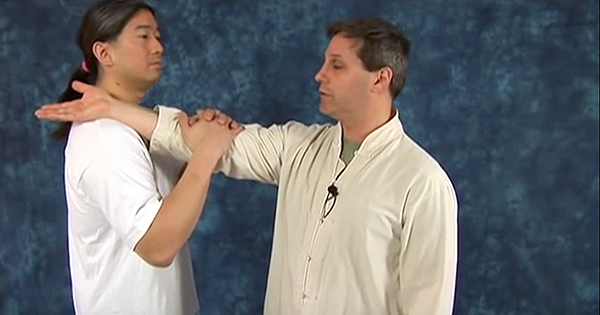The “unbendable arm” demonstration is commonly used in Aikido (合気道) schools, but it is also used in some Taijiquan (太極拳) schools as shown in the following video:
There is a quality that is somewhere between resisting and collapsing that we strive for in Taijiquan. This is reflected in the admonition to avoid butting against (or resisting) as well as avoiding collapsing (ding bian dui kang 顶匾丢抗). The “unbendable arm” exercise can illustrate this middle approach.
In brief, the “unbendable arm” exercise can be performed as follows (although variations are common):
1) Place the wrist of your extended arm on a partner’s shoulder with the palm up.
2) Have the partner place one or both hands on top of the elbow joint and gradually increase the downward force applied to it, seeking to bend the arm.
There are at least five different ways one can respond to the attempt to bend the arm.
1) Resisting the downward pressure by trying to raise the elbow up. This produces an upward force to counter the partner’s downward force. This raising of the elbow is primarily using the extensor muscles (the triceps) to extend the arm, but since the arm (elbow joint) angle is too poor for this action to be strong, it is very difficult to resist the bending of the arm.
2) Resisting by tensing the arm (isometric tension which tightens both the flexor and extensor muscles) in an attempt to lock the arm in position. This is sometimes accentuated with an accompanying clenching of the fist. The arm angle is again too poor to allow the muscles to produce sufficient force, and this resistance is unlikely to succeed unless one’s strength is significantly greater than that of the partner trying to bend the elbow. This approach is also vulnerable to fairly rapid fatigue.
3) Relax! This approach attempts to avoid tensing any arm muscles. This usually results in collapse and cannot resist the bending of the arm (except when done as in #5 below), although one has little fatigue doing this.
4) Activate the flexor muscles (biceps). This just bends one’s own arm and adds to the bending produced by the partner, and cannot succeed in keeping the arm straight.
5) Visualize qi (氣 energy flow; ki in Japanese) rushing through the arm and shooting out of the fingertips. Some methods accompany this visualization with an extension of the finger(s), but this is not necessary. Even the reference to qi is not necessary since many people without any knowledge or cultivation of qi can successfully do the exercise by visualizing the arm as being like a hose with water surging through it. This method allows one to remain feeling relaxed while being able to maintain the straight arm, preventing the partner from bending it!
The effortlessness of the “unbendable arm” illustrates that we are capable of maintaining our structure without fighting against the incoming force, as well as without collapsing! But how is this done? The following is my examination of this phenomenon, and how it relates to the practice of Taijiquan.
I am unaware of any rigorous scientific studies that explain this exercise, so what follows is merely speculation. An article was published in the Journal of International Society of Life Information Science in 2001 (titled “The Physiological Study of Ki in Ki Aikido (2)” by Machi, et al) that attempted to address this issue, but it only had a sample size of ONE experienced practitioner, and thus was not very rigorous and no valid conclusions can be made, although they did make scientific measurements of various physiological variables.
Several web sources attempt to explain the “unbendable arm”, but often use statements that conflict with others. Note that my explanation is also likely to have errors, although I provide information for practitioners to think about. An explanation that includes an examination the above article is given in the following link:
http://umlud.blogspot.com/2013/08/no-ki-energy-does-not-explain.html
What the “unbendable arm” shows us is that there is some mechanism for maintaining structure that does not rely on tensing (or relaxing) the flexor and/or extensor muscles of the body. There are several things that various people invoke to explain this quality (of not resisting but also not collapsing) that is desired in Taijiquan and other martial arts. The most common explanation is probably qi energy, but others include using tendons and/or ligaments rather than muscles, or using “intent” (用意 yongyi) rather than force or, increasingly popular these days, the properties of the fascia, or the stretch reflex.
I’ll start by examining qi as a possible explanation. The classical belief of qi included nearly everything, but specific understandings were contextual. So, while sunlight, which nourishes and vitalizes plants, would be considered as being qi, this would have nothing to do with the “unbendable arm”.
There are many aspects associated with qi that do concern the human body, like the vitality that we obtain from the air we breath and the food we eat, the energy we get from our parents at conception and our constitutions which protect us from diseases, etc., but these are also unlikely to be what allows the “unbendable arm” to work (except for Popeye when he eats his spinach).
Most explanations using qi are probably thinking that it is a physical substance that is coursing through our acupuncture meridians, and that this movement of an energetic substance through our arm is what prevents it from bending. In the broad sense that we need our living vitality to be able to succeed with the “unbendable arm”, then the qi explanation is correct. If our arm is anesthetized or if we are asleep, then we cannot prevent the arm from bending.

Leave a Reply